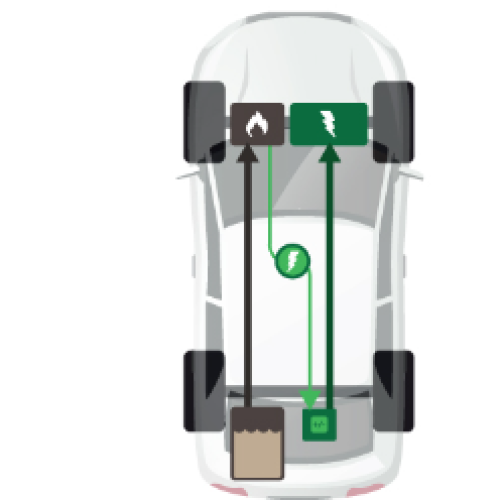Considering an electric vehicle (EV)?
Here’s everything you need to know
Electrified vehicles are powered by an electric motor, instead of a traditional petrol or diesel combustion engine. This means they have zero tailpipe emissions and offer lower running costs.
If you’re thinking of making the switch to an EV but feel daunted, we can help. We've provided the basics here but check out our EV Hub for further information.
If you’ve already made the switch and are new to driving an EV, we’ve created a handy guide of things to consider in our EV Driver Guide, which you can download and keep.
Types of electrified vehicles
Hybrid Electric Vehicle (HEV)

This combines a small battery, an electric motor and a traditional combustion engine. It travels a few miles on electric power before switching back to the combustion engine. The battery is charged through the engine combined with regenerative braking (this means that as the car slows down, its motion is converted into energy that’s then stored in the battery).
Plug-in Hybrid Vehicle (PHEV)

This also has an electric motor and a traditional combustion engine, but it has a larger battery than the HEV. In the same way as the HEV, the battery is partly charged by the engine and regenerative braking - but you’ll need to plug it in and completely charge it to access the full benefits of the electric range.
Battery Electric Vehicle (BEV)

This has a much larger battery than a PHEV, with a fully electric powertrain (the powertrain takes the energy stored in the battery and supplies it to the motors). This vehicle can be charged at home or on the public charging network. Battery range depends on many factors but longer journeys (beyond the vehicle range) will require planning, to incorporate sufficient charging stops.

Frequently asked questions
Charging an EV
There are four main types of charging – slow, fast, rapid and super/ultra-rapid charging. The higher the power output – given in kW (kilowatts) – the faster the charge.
Plug-in vehicles can be charged using either a standard 3-pin socket, or a dedicated EV charge point. A home charge unit will typically be three times faster than a domestic socket, which will make a significant difference when charging a 50kWh+ battery.
To charge your EV, simply use the charging cable(s) provided with your vehicle. One end plugs into the socket on your vehicle, and the other end into the EV charge point or a standard 3-pin socket.
Most EVs come with a mobile app that allows you to monitor charging, and even set the climate control before you get in the car. Great for clearing the ice on a winter’s day. Each vehicle varies but your manufacturer handbook should outline the specific charging instructions for yours. There are also plenty of video tutorials online.
No. While your vehicle is charging, and when it’s fully charged and locked, the cable is interlocked between the car and the charge point. So it cannot be disconnected from the vehicle or the charge unit by anyone other than the key holder.
We recommend using zapmap – one of the best independent and up-to-date sources covering all networks.
A home charge unit will typically be three times faster than a domestic socket, which will make a significant difference when charging a 50kWh+ battery. Through our partnership with British Gas and Hive, we can provide a smart home charger, including installation, from just £909 including VAT* using discount code 30OFFARVAL at checkout (normally £939), when you order a plug-in vehicle from Arval and a charge point from British Gas. Find out more here.
*Your smart charger will be supplied and installed by British Gas. Prices may vary according to installation requirements. Installations at domestic locations in the UK. Terms and conditions apply: Hive Home
If your vehicle isn’t charging, try a different charge point and/or cable. If it still doesn’t work, we’d recommend getting your vehicle checked by a dealership. If you’ve chosen Arval Maintenance or Arval Total Care, you can book an appointment online.
EV range (the number of miles you can drive on one charge)
The electric range of an EV varies by make and model. You can find details of the expected range for your vehicle in the manufacturer handbook. There are also several independent range websites, such as ev-database. It’s important to remember that the actual range achieved is likely to be different to the manufacturer-stated range, as this is calculated under lab conditions.
Like any vehicle, the efficiency of an EV is affected by driving style, speed, load weight, weather, driving conditions, and terrain. Temperature has a big impact on the efficiency of EVs, affecting the range, charging speed, and battery regeneration while driving. Some manufacturer websites provide range calculators to help you understand variance in battery/range performance. A good independent source for range information is ev-database.
Regenerative braking is a system in which the electric motor that normally drives an EV essentially operates in reverse (electrically) during braking or slowing down. Instead of consuming energy from the battery to propel the vehicle, the motor acts as a generator that charges the battery with electrical energy that would normally be lost as heat through traditional mechanical friction brakes. In other words, as the car slows its motion is converted into energy that’s then stored in the battery. Most EVs have the ability to adjust the level of regenerative braking, which has an impact on the range achieved.
If you have any concerns, we recommend getting your vehicle checked by a dealership. If you’ve chosen Arval Maintenance or Arval Total Care, you can book an appointment online.
Additional equipment
Some EVs can be fitted with roof bars, but this will need to be checked with the manufacturer before ordering your vehicle. It’s important to remember that the additional weight of roof bars and a roof box, or bikes, will affect your EV’s range.
Some EVs can tow other vehicles, but you need to check with the manufacturer before ordering your vehicle. Battery packs are heavy, so EVs weigh more than the equivalent petrol or diesel car, and this affects the potential towing weight capacity. The additional weight of towing a trailer or caravan will also affect your EV’s range. However, the torque that is instantly delivered by the EV, and the regenerative braking, can make towing much easier.
EV maintenance
You are responsible for servicing and maintaining your Arval vehicle in accordance with the manufacturer and Government guidelines. Find out more about maintaining your vehicle.
Similar to the fuel gauge on a petrol or diesel vehicle, an EV has a battery gauge and a range indicator. As you near low-battery level, the vehicle will alert you with warning signs and graphics on the dashboard. What to do if you break down.
All major breakdown recovery firms now cover EVs. Some recovery vehicles are equipped with a power pack, but you’re more likely to be taken to the nearest charging station or to your destination. Electric vehicles cannot be towed, as this can damage the electric motor.
New EVs typically come with a battery warranty of at least eight years, or up to 100,000 miles - whichever comes first. Although there will be some slight battery wear over time, which will vary by make and model, batteries are expected to last for significantly longer than the warranty period.
The high voltage battery and electrical systems are fully sealed, so there’s no additional safety risk of driving an EV in flood water. Unlike petrol and diesel vehicles, EVs don’t have an air intake. So the propulsion system isn’t impacted in the same way when immersed in water. However, it’s never a good idea to drive through deep water, and precautions should be taken when driving through standing water in any vehicle.
NEED MORE HELP?

